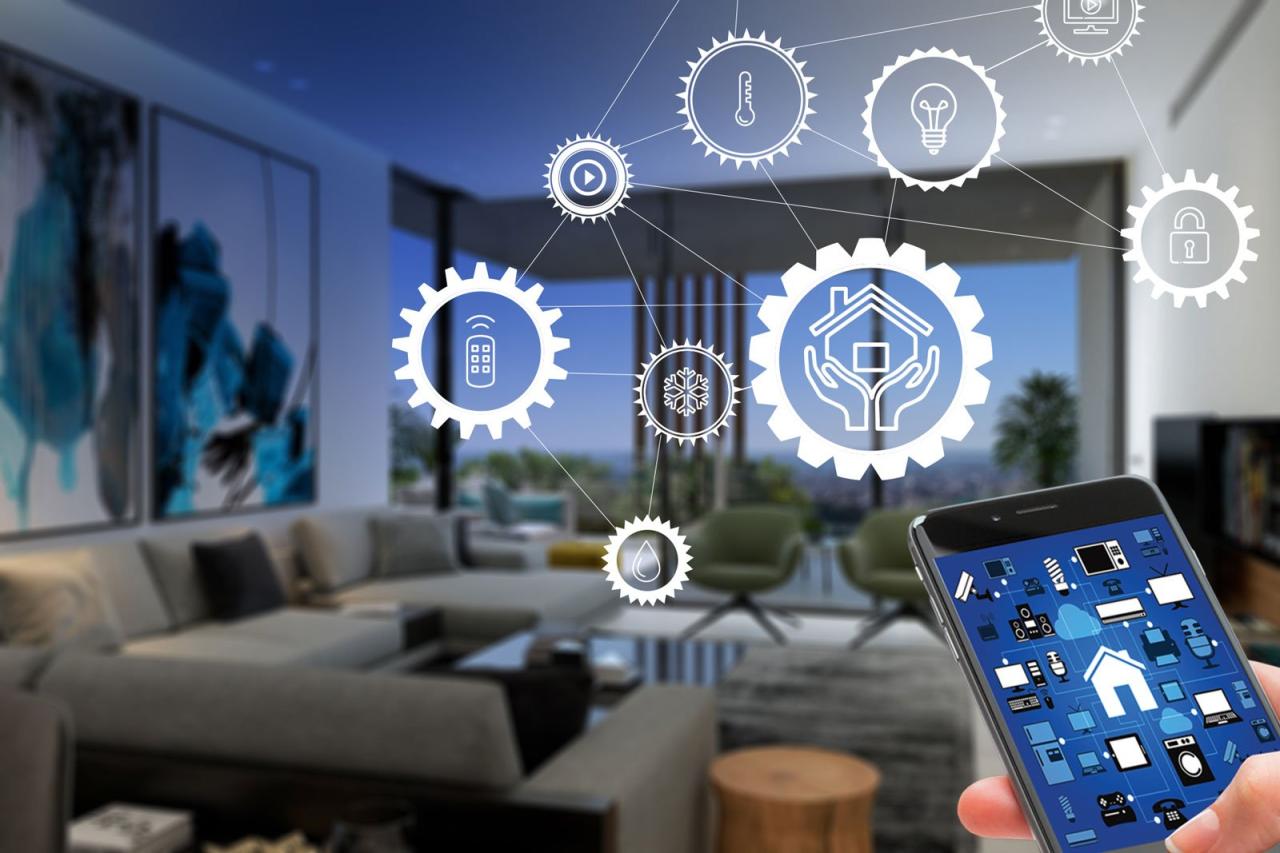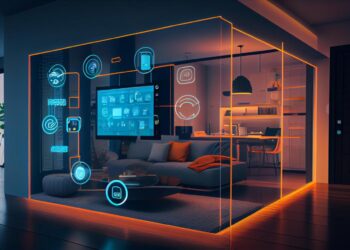The concept of the smart home has rapidly evolved from futuristic fantasy to a tangible reality for millions. At the heart of this transformation lies Artificial Intelligence (AI), the engine driving unprecedented levels of convenience, efficiency, and personalization within our living spaces. No longer merely a collection of connected devices, today’s smart homes are becoming truly intelligent, learning from our habits, anticipating our needs, and seamlessly orchestrating the environment around us. This in-depth article explores the profound impact of AI on the modern home, dissecting its core functionalities, the revolutionary benefits it delivers, the considerable challenges it presents, and the exhilarating future it promises.
The Role of AI in Smart Homes

At its core, AI in a smart home isn’t about robots doing chores (though that’s a growing area too!). Instead, it’s about making devices and systems smarter through data analysis, pattern recognition, and predictive capabilities. It’s the “brain” that allows your smart home to move beyond simple automation to genuine intelligence.
A. Machine Learning (ML) Algorithms: This is the bedrock. ML enables smart home systems to learn from data – your routines, preferences, energy consumption patterns, and even external factors like weather. Over time, the system refines its understanding and improves its responses without explicit programming for every scenario. For instance, your thermostat learns when you typically arrive home and pre-cools the house.
B. Natural Language Processing (NLP): This empowers voice assistants like Amazon Alexa or Google Assistant to understand and process human speech. NLP is what allows you to simply say, “Dim the lights,” and have your smart home respond accurately. It moves beyond keywords, understanding context and intent.
C. Computer Vision: Found in smart cameras and doorbells, computer vision enables these devices to “see” and interpret visual information. This includes facial recognition for unlocking doors, differentiating between a pet and a person, or identifying packages left at your doorstep.
D. Predictive Analytics: Based on collected data and learned patterns, AI can predict future needs or potential issues. This could be predicting when you’ll need to reorder groceries, or even identifying potential appliance malfunctions before they occur.
E. Contextual Awareness: This is where AI truly shines. It allows the smart home to understand the surrounding context. For example, knowing if you’re home or away, the time of day, the weather outside, or if a specific person has entered a room, and then adjusting settings accordingly.
Key AI-Powered Smart Home Applications
AI’s influence is permeating nearly every aspect of the modern dwelling, transforming isolated gadgets into a cohesive, responsive ecosystem.
Enhanced Security and Surveillance
AI is revolutionizing home security, moving beyond simple alarms to proactive, intelligent protection.
- Intelligent Anomaly Detection: Smart cameras with AI can distinguish between genuine threats (e.g., an unfamiliar person lingering) and benign events (e.g., a pet moving, a passing car). They can alert you only when necessary, reducing false alarms.
- Facial and Object Recognition: AI-powered doorbells can identify family members or known visitors, providing custom greetings or granting access. They can also recognize packages, alerting you to deliveries.
- Predictive Security Analytics: Over time, AI can learn patterns of activity around your home. If an unusual pattern emerges, it can flag it as potentially suspicious.
- Audio Analytics: Beyond just visual, AI can detect unusual sounds like breaking glass or smoke alarms, even when you’re not home, and send immediate alerts.
- Virtual Patrols: Some advanced systems can simulate occupancy when you’re away by randomly adjusting lights and blinds, making the home appear occupied.
Intelligent Energy Management
AI empowers homes to become significantly more energy-efficient, leading to substantial cost savings and a reduced environmental footprint.
- Learning Thermostats: Devices like Nest learn your preferred temperatures, daily routines, and even local weather patterns to optimize heating and cooling schedules, minimizing energy waste. They can adjust based on occupancy detected by sensors.
- Smart Lighting Optimization: AI-driven lighting systems learn when and where you need light, adjusting brightness and color temperature based on time of day, natural light availability, and occupancy. Lights can automatically turn off in empty rooms.
- Appliance Optimization: Future smart appliances with AI will monitor their own energy consumption, suggest optimal usage times, and even self-diagnose issues that could lead to energy inefficiency.
- Grid Integration: AI in smart homes can interact with the broader energy grid, shifting high-energy tasks (like charging an EV or running a dishwasher) to off-peak hours when electricity is cheaper or cleaner.
Personalized Comfort and Ambiance
AI creates a living environment that adapts to your individual preferences, making your home a truly personalized sanctuary.
- Contextual Climate Control: Beyond learning schedules, AI can consider real-time factors like the number of people in a room, their body heat, and even individual preferences (if multiple users are identified) to fine-tune temperature.
- Dynamic Lighting Scenes: AI can create personalized lighting scenes based on activities (e.g., “reading mode,” “movie night”), time of day, or even your mood, adjusting color and intensity.
- Proactive Environmental Adjustments: If the AI detects high pollen counts outside, it might suggest closing windows and activating an air purifier before you even feel symptoms.
- Personalized Music and Media: AI-powered speakers and media centers learn your musical tastes and can suggest playlists, adjust volume based on ambient noise, or seamlessly transition music from room to room as you move.
Autonomous Home Maintenance and Management
AI is moving us towards a future where routine home maintenance is automated, and potential issues are detected proactively.
- Predictive Appliance Maintenance: Smart appliances with embedded AI can monitor their own performance and predict when parts might fail, alerting you to schedule maintenance before a breakdown occurs. This applies to refrigerators, washing machines, HVAC systems, and more.
- Robotic Assistants: AI is the brain behind robotic vacuums, mops, and even lawnmowers, allowing them to navigate complex environments, learn floor plans, and optimize their cleaning routes.
- Inventory Management: Smart refrigerators can track contents, suggest recipes based on available ingredients, and even automatically reorder staples when supplies run low.
- Waste Management Optimization: Smart bins equipped with AI-powered sensors can identify waste types, suggest proper recycling, and notify waste collection services when full, optimizing collection routes.
Enhanced Accessibility and Assistance

AI is making smart homes more inclusive and supportive for individuals with diverse needs, particularly the elderly or those with disabilities.
- Voice Control for Everything: For those with mobility limitations, voice commands become a primary interface for controlling lights, thermostats, doors, and entertainment systems.
- Personalized Reminders and Prompts: AI assistants can remind elderly residents to take medication, attend appointments, or even check if they’ve eaten.
- Fall Detection and Emergency Alerts: Wearable devices and in-home sensors with AI can detect falls and automatically alert caregivers or emergency services.
- Adaptive Environments: The home can dynamically adjust to the specific needs of an occupant, for example, increasing light levels for someone with impaired vision as they enter a room.
- Smart Caregiver Support: AI systems can provide caregivers with real-time insights into the well-being and daily routines of those they care for, offering peace of mind and supporting independent living.
The Transformative Benefits of AI-Driven Homes
The integration of AI into our living spaces brings a host of tangible advantages that go beyond mere technological novelty.
A. Unparalleled Convenience and Comfort:
- Effortless Automation: AI removes the need for manual adjustments, making daily routines smoother. Lights turn on as you enter a room, coffee brews as you wake up, and the temperature is always just right.
- Personalized Experiences: The home proactively adapts to your preferences, creating an environment that feels uniquely tailored to your lifestyle.
- Time Savings: Automating repetitive tasks frees up valuable time for more meaningful activities.
B. Significant Energy Savings and Environmental Impact:
- Reduced Utility Bills: Intelligent energy management systems can lead to substantial reductions in electricity, heating, and cooling costs.
- Lower Carbon Footprint: By optimizing energy consumption, smart homes contribute to reduced greenhouse gas emissions, supporting environmental sustainability efforts.
- Resource Conservation: Smart water systems minimize waste, further enhancing the home’s ecological efficiency.
C. Enhanced Safety and Security:
- Proactive Threat Detection: AI’s ability to differentiate between normal and abnormal activity provides a more reliable and less intrusive security system.
- Remote Monitoring and Control: Whether at work or on vacation, homeowners can monitor their property and control systems from anywhere, providing peace of mind.
- Emergency Preparedness: AI can integrate with smoke detectors, CO alarms, and even water leak sensors, alerting you to potential dangers immediately.
D. Increased Accessibility and Support:
- Empowering Independent Living: AI-powered features significantly enhance the ability of the elderly and individuals with disabilities to live independently and safely in their homes.
- Streamlined Daily Tasks: Voice control and automation simplify everyday actions that might otherwise be challenging.
- Caregiver Support: Provides valuable data and alerts to caregivers, ensuring better oversight and faster response in emergencies.
E. Improved Property Value and Future-Proofing:
- Modern Appeal: Homes equipped with advanced AI features are increasingly attractive to buyers, potentially increasing market value.
- Adaptability: AI-powered systems are often designed to be modular and upgradeable, allowing homes to evolve with new technologies rather than becoming obsolete.
- Reduced Maintenance Costs: Predictive maintenance can prevent costly breakdowns and extend the lifespan of appliances and systems.
Navigating the Challenges of AI in Smart Homes
Despite the exciting prospects, the widespread adoption and optimal functioning of AI in smart homes face several significant hurdles that require careful consideration and innovative solutions.
A. Data Privacy and Security Risks:
- Vast Data Collection: AI thrives on data, meaning smart homes collect an immense amount of information about occupants’ habits, routines, and personal preferences. This raises serious questions about who owns this data, how it’s stored, and whether it’s vulnerable to breaches.
- Cybersecurity Vulnerabilities: Every connected device represents a potential entry point for hackers. A compromised smart home could expose sensitive data, allow unauthorized surveillance, or even be leveraged in larger botnet attacks.
- Lack of Transparency: Users often don’t fully understand what data is being collected, how it’s used, or with whom it’s shared. Clear, concise privacy policies are crucial but often lacking.
B. Interoperability and Standardization Issues:
- Fragmented Ecosystem: The smart home market is highly fragmented, with numerous manufacturers and platforms (e.g., Apple HomeKit, Google Home, Amazon Alexa, Samsung SmartThings). Devices from different ecosystems often struggle to communicate seamlessly.
- Vendor Lock-in: Consumers can become “locked in” to a particular brand or ecosystem, limiting their choices for future device purchases.
- Need for Universal Standards: The lack of universally adopted communication protocols (like Matter, which aims to address this) hinders true plug-and-play functionality across different brands.
C. High Initial Costs and Complexity:
- Expense of AI-Powered Devices: While prices are dropping, investing in a comprehensive AI-driven smart home system still requires a significant initial outlay for devices, hubs, and potential professional installation.
- Setup and Maintenance Complexity: Setting up and troubleshooting an interconnected web of devices can be daunting for non-tech-savvy users, leading to frustration and underutilization of features.
- Ongoing Subscriptions: Many advanced AI features or cloud storage for security footage come with recurring subscription fees, adding to the long-term cost.
D. Ethical and Societal Implications:
- Bias in AI Algorithms: If not carefully designed, AI algorithms can perpetuate or even amplify existing societal biases, for example, in facial recognition systems.
- Job Displacement: While creating new tech jobs, the automation of household tasks could potentially impact some service industries.
- Over-reliance and Loss of Skills: An overly automated home might lead to a decreased ability for individuals to perform basic tasks or solve simple problems.
- Digital Divide: As smart homes become more prevalent, there’s a risk of widening the gap between those who can afford and benefit from these technologies and those who cannot.
E. Reliability and Performance:
- Network Dependence: Smart home systems heavily rely on stable internet connectivity. Outages can render many smart features useless.
- Software Glitches: As with any complex software, bugs and glitches can occur, leading to frustrating malfunctions or security vulnerabilities.
- Power Outages: Without battery backup, many smart home features will cease to function during power cuts.
F. Public Acceptance and Trust:
- Fear of Surveillance: Some individuals are apprehensive about constant monitoring by devices within their own homes, fearing surveillance by corporations or governments.
- Comfort with Technology: A segment of the population remains hesitant to embrace new technologies, preferring traditional methods.
- Understanding the Value Proposition: Clearly communicating the tangible benefits of AI in the home is crucial to overcome skepticism and encourage adoption.
The Future of AI in Our Homes
The trajectory of AI’s integration into smart homes points towards an increasingly sophisticated, intuitive, and seamlessly integrated future. We can expect several key developments:
A. Truly Proactive and Intuitive Systems: Future AI will move beyond reacting to commands to truly anticipating needs with remarkable accuracy. Imagine your home not just adjusting temperature but also suggesting specific activities based on your mood, energy levels, and even biometric data gathered from wearables.
B. Hyper-Personalization at Scale: AI will enable homes to adapt to the individual preferences of multiple occupants simultaneously, creating personalized zones and experiences within the same living space.
C. Edge AI and Enhanced Privacy: More AI processing will occur directly on devices (at the “edge”) rather than relying solely on cloud servers. This will lead to faster response times, reduced latency, and crucially, enhanced data privacy as less sensitive information leaves the home.
D. Self-Healing and Self-Optimizing Homes: AI will enable homes to self-diagnose issues, schedule maintenance, and even autonomously make minor repairs. Think of a heating system that reconfigures itself to improve efficiency when a component starts to degrade.
E. Deeper Integration with External Services: The smart home will become more seamlessly integrated with external services like healthcare providers, delivery services, and community networks, creating a truly connected living experience.
F. Enhanced Emotional Intelligence in AI: While still nascent, research into AI’s ability to understand and respond to human emotions could lead to AI assistants that offer more empathetic and supportive interactions.
Conclusion
The convergence of advanced AI, ubiquitous connectivity, and ever-smarter sensors is transforming our homes into active participants in our lives. As these technologies mature and become more accessible, the lines between our digital and physical worlds will blur further, creating living environments that are not just intelligent, but truly intuitive, supportive, and fundamentally enhance our well-being. The future of the home is undeniably intelligent, powered by the continuous evolution of Artificial Intelligence.











